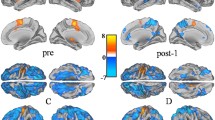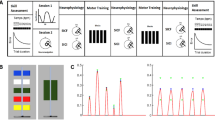Abstract
Neuroimaging studies suggest that the primary hand motor area and the cerebellum play a pivotal role in the control of finger tapping, but their differential contribution in this task is unknown. We used therefore repetitive transcranial magnetic stimulation (rTMS) in its virtual lesion mode (1 Hz, 10 min, 90% of motor threshold) to study the effects of transient disruption of the right lateral cerebellum (CB), the left primary hand motor area (M1), and the right brachial plexus (PL, control site) on various finger tapping tasks (paced finger tapping task: PFT; tapping with maximum speed: TAPMAX, and tapping with convenient speed: TAPCON) in healthy right-handed subjects. RTMS of the left M1 slowed finger tapping speed of the right hand in the TAPMAX task. This effect eliminated the right hand superiority in the TAPMAX task. In addition, rTMS of the left M1 resulted in slower tapping speeds for both hands during TAPCON. There were no other effects of rTMS on tapping speed or tapping variability. Findings indicate that M1 is essential for generating fastest finger movements.


Similar content being viewed by others
References
Alkadhi H, Crelier GR, Boendermaker SH, Hepp-Reymond MC, Kollias SS (2002) Somatotopy in the ipsilateral primary motor cortex. Neuroreport 13:2065–2070
Amunts K, Schlaug G, Jäncke L, Steinmetz H, Schleicher A, Zilles K (1997) Hand skills covary with the size of motor cortex: a macrostructural adaptation. Hum Brain Mapp 5:206–215
Amunts K, Jäncke L, Mohlberg H, Steinmetz H, Zilles K (2000) Interhemispheric asymmetry of the human motor cortex related to handedness and gender. Neuropsychologia 38:304–312
Ashe J, Georgopoulos AP (1994) Movement parameters and neural activity in motor cortex and area 5. Cereb Cortex 4:590–600
Civardi C, Cantello R, Asselman P, Rothwell JC (2001) Transcranial magnetic stimulation can be used to test connections to primary motor areas from frontal and medial cortex in humans. Neuroimage 14:1444–1453
Cohen J (1969) Statistical power analysis for the behavioral sciences. Academic Press, New York
Curt A, Alkadhi H, Crelier GR, Boendermaker SH, Hepp-Reymond MC, Kollias SS (2002) Changes of non-affected upper limb cortical representation in paraplegic patients as assessed by fMRI. Brain 125:2567–2578
Enomoto H, Ugawa Y, Hanajima R, Yuasa K, Mochizuki H, Terao Y, Shiio Y, Furubayashi T, Iwata NK, Kanazawa I (2001) Decreased sensory cortical excitability after 1 Hz rTMS over the ipsilateral primary motor cortex. Clin Neurophysiol 112:2154–2158
Gerschlager W, Siebner HR, Rothwell JC (2001) Decreased corticospinal excitability after subthreshold 1 Hz rTMS over lateral premotor cortex. Neurology 57:449–455
Gerschlager W, Christensen LO, Bestmann S, Rothwell JC (2002) rTMS over the cerebellum can increase corticospinal excitability through a spinal mechanism involving activation of peripheral nerve fibres. Clin Neurophysiol 113:1435–1440
Hepp-Reymond MC (1988) Functional organization of motor cortex and its participation in voluntary movements. In: Seklis HD, Erwin J (eds) Comparative primate biology. Liss, New York, pp 501–624
Holm S (1979) A simple sequentially rejective multiple test procedure. Scand J Stat 6:65–70
Humphrey DR (1972) Relating motor cortex spike trains to measures of motor performance. Brain Res 40:7–18
Ivry RB, Keele SW, Diener HC (1988) Dissociation of the lateral and medial cerebellum in movement timing and movement execution. Exp Brain Res 73:167–180
Jäncke L, Schlaug G, Steinmetz H (1997) Hand skill asymmetry in professional musicians. Brain Cogn 34:424–432
Jäncke L, Peters M, Schlaug G, Posse S, Steinmetz H, Muller-Gartner H (1998a) Differential magnetic resonance signal change in human sensorimotor cortex to finger movements of different rate of the dominant and subdominant hand. Brain Res Cogn Brain Res 6:279–284
Jäncke L, Specht K, Mirzazade S, Loose R, Himmelbach M, Lutz K, Shah NJ (1998b) A parametric analysis of the ‘rate effect’ in the sensorimotor cortex: a functional magnetic resonance imaging analysis in human subjects. Neurosci Lett 252:37–40
Kim SG, Ashe J, Georgopoulos AP, Merkle H, Ellermann JM, Menon RS, Ogawa S, Ugurbil K (1993a) Functional imaging of human motor cortex at high magnetic field. J Neurophysiol 69:297–302
Kim SG, Ashe J, Hendrich K, Ellermann JM, Merkle H, Ugurbil K, Georgopoulos AP (1993b) Functional magnetic resonance imaging of motor cortex: hemispheric asymmetry and handedness. Science 261:615–617
Kosslyn SM, Pascual-Leone A, Felician O, Camposano S, Keenan JP, Thompson WL, Ganis G, Sukel KE, Alpert NM (1999) The role of area 17 in visual imagery: convergent evidence from PET and rTMS. Science 284:167–170
Lee L, Siebner HR, Rowe JB, Rizzo V, Rothwell JC, Frackowiak RS, Friston KJ (2003) Acute remapping within the motor system induced by low-frequency repetitive transcranial magnetic stimulation. J Neurosci 23:5308–5318
Lutz K, Specht K, Shah NJ, Jäncke L (2000) Tapping movements according to regular and irregular visual timing signals investigated with fMRI. Neuroreport 11:1301–1306
Lutz K, Weidner R, Shah NJ, Jäncke L (2001) The transfer of a timing pattern to the untrained human hand investigated with functional magnetic resonance imaging. Neurosci Lett 301:45–48
Matelli M, Camarda R, Glickstein M, Rizzolatti G (1986) Afferent and efferent projections of the inferior area 6 in the macaque monkey. J Comp Neurol 251:281–298
Munchau A, Bloem BR, Irlbacher K, Trimble MR, Rothwell JC (2002) Functional connectivity of human premotor and motor cortex explored with repetitive transcranial magnetic stimulation. J Neurosci 22:554–561
Parlow SE, Kinsbourne M (1989) Asymmetrical transfer of training between hands: implications for interhemispheric communication in normal brain. Brain Cogn 11:98–113
Pascual-Leone A, Valls-Sole J, Wassermann EM, Hallett M (1994) Responses to rapid-rate transcranial magnetic stimulation of the human motor cortex. Brain 117:847–858
Peters M (1977) Simultaneous performance of two motor activities: the factor of timing. Neuropsychologia 15:461–465
Peters M (1981) Handedness: coordination of within- and between-hand alternating movements. Am J Psychol 94:633–643
Peters M (1998) Description and validation of a flexible and broadly usable hand preference questionnaire. Laterality 3:77–96
Plewnia C, Lotze M, Gerloff C (2003) Disinhibition of the contralateral motor cortex by low-frequency rTMS. Neuroreport 14:609–612
Rao SM, Bandettini PA, Binder JR, Bobholz JA, Hammeke TA, Stein EA, Hyde JS (1996) Relationship between finger movement rate and functional magnetic resonance signal change in human primary motor cortex. J Cereb Blood Flow Metab 16:1250–1254
Rao SM, Harrington DL, Haaland KY, Bobholz JA, Cox RW, Binder JR (1997) Distributed neural systems underlying the timing of movements. J Neurosci 17:5528–5535
Rossi S, Pasqualetti P, Rossini PM, Feige B, Ulivelli M, Glocker FX, Battistini N, Lucking CH, Kristeva-Feige R (2000) Effects of repetitive transcranial magnetic stimulation on movement-related cortical activity in humans. Cereb Cortex 10:802–808
Rossini PM, Barker AT, Berardelli A, Caramia MD, Caruso G, Cracco RQ, Dimitrijevic MR, Hallett M, Katayama Y, Lucking CH (1994) Non-invasive electrical and magnetic stimulation of the brain, spinal cord and roots: basic principles and procedures for routine clinical application. Report of an IFCN committee. Electroencephalogr Clin Neurophysiol 91:79–92
Schlaghecken F, Munchau A, Bloem BR, Rothwell J, Eimer M (2003) Slow frequency repetitive transcranial magnetic stimulation affects reaction times, but not priming effects, in a masked prime task. Clin Neurophysiol 114:1272–1277
Sommer M, Kamm T, Tergau F, Ulm G, Paulus W (2002) Repetitive paired-pulse transcranial magnetic stimulation affects corticospinal excitability and finger tapping in Parkinson’s disease. Clin Neurophysiol 113:944–950
Strens LH, Oliviero A, Bloem BR, Gerschlager W, Rothwell JC, Brown P (2002) The effects of subthreshold 1 Hz repetitive TMS on cortico-cortical and interhemispheric coherence. Clin Neurophysiol 113:1279–1285
Taylor HG, Heilman KM (1980) Left-hemisphere motor dominance in righthanders. Cortex 16:587–603
Theoret H, Haque J, Pascual-Leone A (2001) Increased variability of paced finger tapping accuracy following repetitive magnetic stimulation of the cerebellum in humans. Neurosci Lett 306:29–32
Thut G, Cook ND, Regard M, Leenders KL, Halsband U, Landis T (1996) Intermanual transfer of proximal and distal motor engrams in humans. Exp Brain Res 108:321–327
Ugawa Y, Uesaka Y, Terao Y, Hanajima R, Kanazawa I (1995) Magnetic stimulation over the cerebellum in humans. Ann Neurol 37:703–713
Wassermann EM (1998) Risk and safety of repetitive transcranial magnetic stimulation: report and suggested guidelines from the International Workshop on the Safety of Repetitive Transcranial Magnetic Stimulation, June 5–7, 1996. Electroencephalogr Clin Neurophysiol 108:1–16
Wassermann EM, Grafman J, Berry C, Hollnagel C, Wild K, Clark K, Hallett M (1996) Use and safety of a new repetitive transcranial magnetic stimulator. Electroencephalogr Clin Neurophysiol 101:412–417
Werhahn KJ, Taylor J, Ridding M, Meyer BU, Rothwell JC (1996) Effect of transcranial magnetic stimulation over the cerebellum on the excitability of human motor cortex. Electroencephalogr Clin Neurophysiol 101:58–66
Wise SP (1985) The primate premotor cortex: past, present, and preparatory. Annu Rev Neurosci 8:1–19
Wittmann M, Von Steinbuchel N, Szelag E (2001) Hemispheric specialisation for self-paced motor sequences. Brain Res Cogn Brain Res 10:341–344
Author information
Authors and Affiliations
Corresponding author
Rights and permissions
About this article
Cite this article
Jäncke, L., Steinmetz, H., Benilow, S. et al. Slowing fastest finger movements of the dominant hand with low-frequency rTMS of the hand area of the primary motor cortex. Exp Brain Res 155, 196–203 (2004). https://doi.org/10.1007/s00221-003-1719-7
Received:
Accepted:
Published:
Issue Date:
DOI: https://doi.org/10.1007/s00221-003-1719-7




